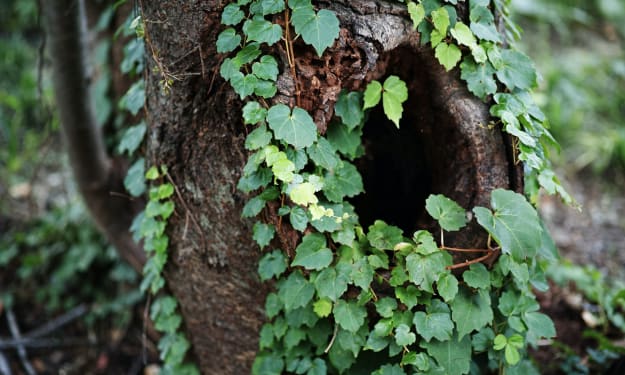Dancing With The Shadows of My Soul
From dark purple to bright perspectives

I took a poetry class in my second year of university. It was one of my favourite classes ever, and I always appreciated the way that my professor taught us how to craft more than just a piece of poetry, but a scene. How he showed us that the details were important too, not just the story. Maybe that's why I've always been interested in romanticizing my life.
I can't remember a time when I didn't struggle with mental health challenges. I've always had this sadness. Sometimes it's extremely intense, and other times it just lingers.
In that class, I wrote a poem about my sadness and described it as dark purple. I described it as bruises that never fade. That poem got a good grade, but it was about more than that for me. It felt true, it felt like I had bruises, even though I had no idea of the trauma that lay ahead of me.
Flash forward to eight or so years later, and I understand what I said now when I said that sadness can be like bruises that never fade. It feels like I have all of these bruises, but because of my mental illnesses, they'll never be able to heal.
Surviving The Abyss
I don't think I was ever formally diagnosed with depression. From what I remember, I went to the school psychologist, and they recommended that I see a therapist. Next thing I knew, I was 17 years old and standing in my living room, telling my mom that I didn't want to be "here" anymore. I was sent to a therapist for a few sessions after that, but nothing ever evolved.
The first talk of a diagnosis that I remember was in my first year of university, when some sort of school counsellor or doctor or something said that I might have a personality disorder in Cluster B. I looked into it a little bit, but pretty much forgot about it.
Everything came to a head in July 2017, the summer of my attempted suicide. Rewind the time just over half a year, and I was standing in my room straightening my hair for school, thinking about how I was the saddest that I'd ever been. And then I met a boy. He showed me what love was, briefly, and then brought me into a real life nightmare. For seven months, I was madly enamored with him, up until the day that he died, the day of my overdose. You see, I would have followed him anywhere. Everything went according to plan, except for one part — I had survived.
In the remains of the trauma, I was diagnosed with bipolar disorder, type II. This was the first diagnosis that really made sense to me. I related to the manic episodes, where I remember singing to my mom while I danced on top of the coffee table. And I of course related to the depression, finally an explanation for the deep and dark feelings that I had always known so well.
In the years following, many terms have been thrown around. I relate the most to my bipolar diagnosis, my PTSD diagnosis, and my diagnosis of having traits of borderline personality disorder (BPD). Funnily enough, BPD is a personality disorder in Cluster B, just like that person at my university had said all of those years ago.
The thing about BPD is that most people don't start to show symptoms until the late teen years and into early adulthood, and those symptoms can be triggered by a traumatic experience, such as what I went through. So it seemed like things got worse for me mentally after the overdose, and it turns out, they did.
Now that you know the whole story, you should be able to see how much of a mess I truly am. I put on a façade that I have it all together, but that's nowhere near true, and I am working every day to rediscover myself on this very messy and unpredictable journey.
A Lazy Girl's Approach to Life's Small Pleasures
I've found it helpful to adapt easy and practical exercises into my routines, because let's face it, I'm a lazy girlie. My morning routine is short and efficient, including a good combination of what I need to do and what I want to do.
Mindfulness has never been easy for me, and maybe that's why I never prospered in all of those DBT classes. My mind is always running, and the world is always muted. I have a hard time tuning in. But I like to practice mindfulness by becoming aware of the small moments and enjoying them, because there's more to life than all of the unnecessary stress that we add on.
Throughout the years, I've always been able to express myself and my passion through various outlets, whether it be my writing roots, pushing myself to be of service to others, or even creating content that I care about. Spiritually, I connect myself to God in ways that feel good to me, and I practice tarot in a way that makes sense to me. I believe that belief is personal and it should be whatever you want it to be, which may be jarring for some who seek religion and spirituality for practice and tradition.
What I'm saying is that life can be really difficult when you struggle with mental health issues, especially when you're still trying to discover yourself. But I want you to remember that you don't need to know what you're doing and that you can choose how your journey goes. You cannot control what happens, but you can control your perspective on the situation and how you choose to feel about it.

From diagnosis to diagnosis, sadness has always remained, but I find small ways to make it seem not as intimidating and heavy. Some of these ways are traditional and others are not, but the important part is that they work for me. Every person's journey is different, as each person on this planet is so unique. Find the things that work for you and do those things, because those are the things that will help you stay balanced when the ground starts to rumble again.
If you're feeling good, take advantage of that and think about the things that led you to this feeling, and take note. Think of your life like a puzzle, where you get to put the pieces together how you want, and it might not fit on the first try. However, you'll eventually be able to see the bigger picture.
About the Creator
Amanda Doyle
Currently in my "figuring it the hell out" era.
Big believer in everything happening for a reason, second chances, and the fact that we're living in a simulation.
Check out my podcast: https://podcasters.spotify.com/pod/show/semimindfulbanter






Comments (1)
Thanks for the read. Life is hard, really hard when mental illness is a part of it, but it has its joys also. Reading others' experiences here in Psych is a pleasant balm for my boredom and bittersweet mood. Thanks,